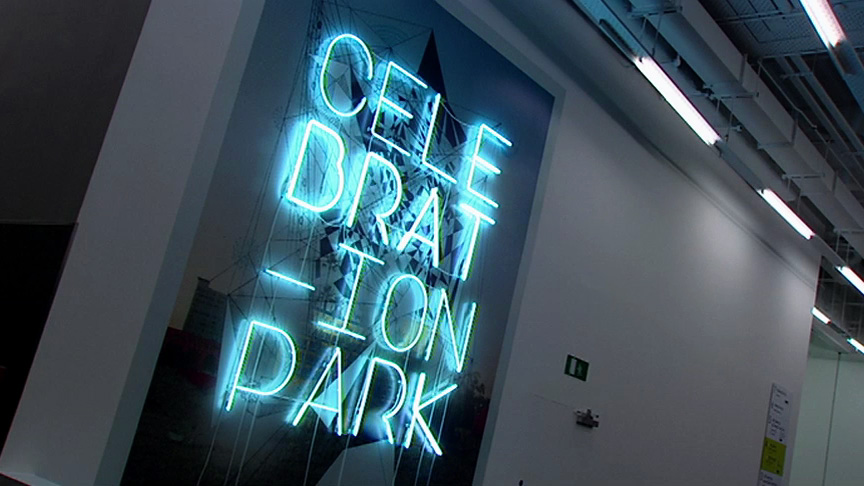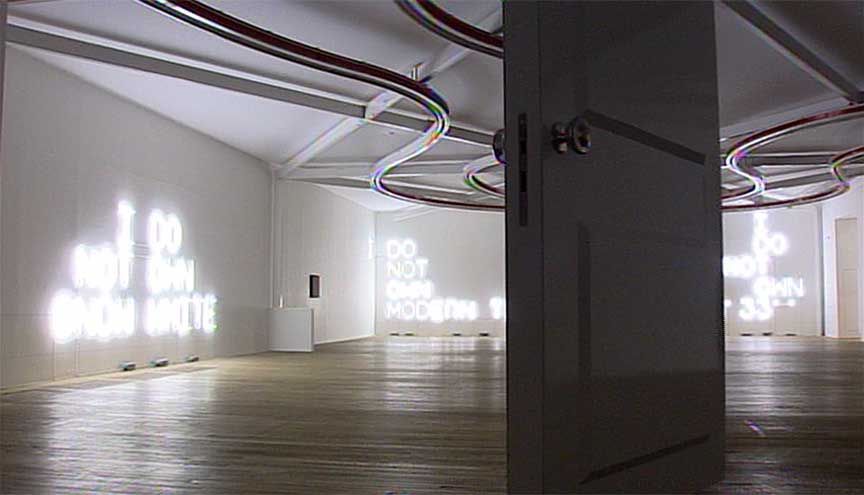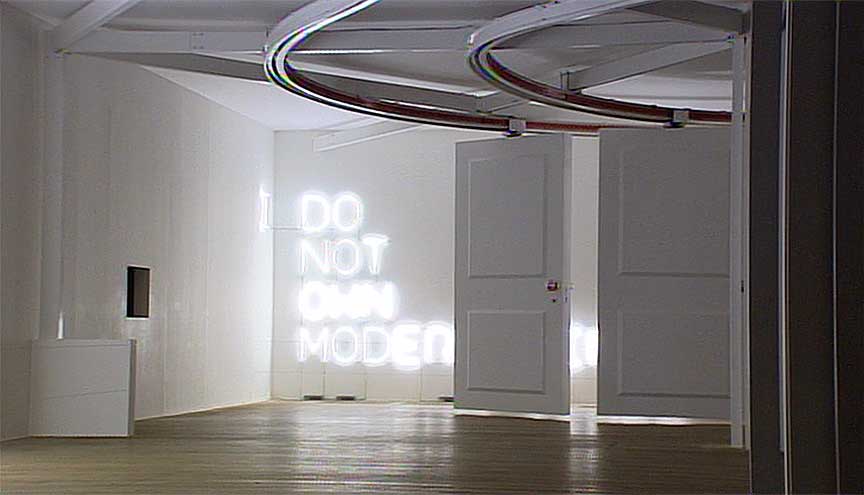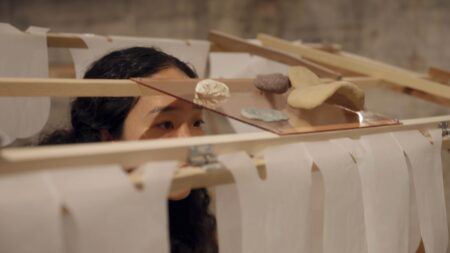Interview
“Celebration Park”

Pierre Huyghe. Celebration Park, 2006. Installation view at Tate Modern, London, 2006. Artwork courtesy Marian Goodman Gallery, Paris/New York. Production still from the Art in the Twenty-First Century Season 4 episode, Romance. Photo: © Art21, Inc. 2007. Artwork: © Pierre Huyghe.
Artist Pierre Huyghe discusses his 2006 installation Celebration Park.
ART21: Can you talk about the meaning of the title Celebration Park, which you’ve used for two recent exhibitions?
HUYGHE: What I mean by [the word] celebration is that it’s something you participate in. With Celebration Park at the Tate and at the ARC in Paris, when you celebrate, you’re not so much observing outside the world, you’re participating in this world. Part of the title is really about this idea of not being critical, but being participatory.
ART21: You see a relationship between exhibitions and celebrations?
HUYGHE: You know, the opening of a show is always a celebration. And the opening of the show at the ARC was the reopening of this museum. This was the celebration of the starting point of a place. For me, this exhibition was a show about another show, an exhibition about another exhibition to come. I was interested to see if this exhibition could be a kind of model of something—even less than a model—an intuition for a permanent exhibition to come.
ART21: Is Celebration Park playing with the idea of art as an amusement park?
HUYGHE: I think I’m even more interested in the model of a World’s Fair. I’m interested in the singularity of each pavilion. The idea was to think about a collective exhibition: each pavilion of this World’s Fair will be done by an artist. So, in a certain way, the exhibition will be a permanent exhibition.

Pierre Huyghe. Celebration Park, 2006. Installation view at Tate Modern, London, 2006. Artwork courtesy of Marian Goodman Gallery, Paris/New York. Production still from the Art in the Twenty-First Century Season 4 episode, Romance. Photo: © Art21, Inc. 2007. Artwork: © Pierre Huyghe.
ART21: The World’s Fair is certainly an intriguing model.
HUYGHE: We should not forget that the Museum of Modern Art of the city of Paris was done for the World’s Fair. It was closed for two years, and now the fair is reopening, in a way.
ART21: Were there differences between the Celebration Park exhibitions in England and in France?
HUYGHE: The show at the Tate started early on in Paris. It was not exactly the same show. One was more experimental and intuitive; the other one was more constructed.
ART21: What is the framework for the exhibition?
HUYGHE: Celebration Park is a collection of exhibitions, a set of singular experiences. The format of exhibition is something to work on: it’s a form in itself. Usually an artist thinks of an exhibition as an end point, a resolution of something. He’s working in his studio, and there’s a process, and at the end of this process, he’s showing his work in what we call an exhibition. I’m not interested in that. I’m interested that the exhibition is not the end of the process but a starting point to go somewhere else. In a certain way, that’s what this is all about.

Pierre Huyghe. Celebration Park, 2006. Installation view at Tate Modern, London, 2006. Artwork courtesy of Marian Goodman Gallery, Paris/New York. Production still from the Art in the Twenty-First Century Season 4 episode, Romance. Photo: © Art21, Inc. 2007. Artwork: © Pierre Huyghe.
ART21: Talk about the way Celebration Park functions as an experience.
HUYGHE: What you have here at the Tate is a kind of collection of exhibitions. Like the World’s Fair, you go from one pavilion to the next. You enter one pavilion, and you have an experience. Sometimes this experience is about progress or social behavior. And then you go to another pavilion where you have a completely different experience.
ART21: And it contains the work you’ve done here, in the U.S.?
HUYGHE: Yes. North of New York City, I did a one-day celebration in a new town. And I did a small puppet play at Harvard. I even built a pavilion, in which is a small puppet theater. I went to Antarctica, and to express this experience, I did a kind of musical in Central Park.
ART21: Do you see connections that run throughout the individual works?
HUYGHE: My work since The Association Of Freed Time in 1994 has always been about this time-based protocol. It has always been about the exhibition itself, the exhibition being a starting point.

Pierre Huyghe. Celebration Park, 2006. Installation view at Tate Modern, London, 2006. Artwork courtesy of Marian Goodman Gallery, Paris/New York. Production still from the Art in the Twenty-First Century Season 4 episode, Romance. Photo: © Art21, Inc. 2007. Artwork: © Pierre Huyghe.
ART21: What do you first see when you walk into the show?
HUYGHE: You enter the gallery, and you see all these neon disclaimers, the kinds of statements you make in order not to be sued if you use something that belongs to someone else. It’s a copyright issue, a legal problem, so you have to say, “I used that, but it’s not mine.” And then, because you say, “It’s not mine,” you have the right to use it in a certain way. Of course, in my work I have used the voice of Snow White, the music of John Cage, and now I’m also actually using the museum.
What do people think when they enter the museum and see “I do not own Snow White”? They can relate. Snow White is a character we all share. But you need to play with this culture in order to be part of it. There’s a production of symbolic material, and you need to be part of it and use it. When you read the text, you say with your inner voice, “I myself do not own Snow White, but I know how she sings.” You enter into the play of knowing or not knowing if you own the culture.
ART21: Is Snow White a metaphor for something larger?
HUYGHE: I’m very interested in how things circulate in a certain way—how stories circulate. You used to be able to have a narrative and circulate it through a narrator, and the story would grow and go on indefinitely. But today, you cannot do that because there’s a copyright attached to it. The story can expand, but it always has to go back to the original because of the copyright issue. Between us, we can sing the song of Snow White, but not publicly. This is about the circulation of stories—how we can tell stories to each other, how fluid or not this is.

Pierre Huyghe. Celebration Park, 2006. Installation view at Tate Modern, London, 2006. Artwork courtesy of Marian Goodman Gallery, Paris/New York. Production still from the Art in the Twenty-First Century Season 4 episode, Romance. Photo: © Art21, Inc. 2007. Artwork: © Pierre Huyghe.
ART21: Is there something symbolic about the moving doors that are part of the installation?
HUYGHE: They suspend the moment of opening, forever. Usually a door is a fixed object: you’re in or you’re out. You can or cannot gain access to something. Here, the doors are moving, so you don’t even know any more where “outside” is. Who says a door is a threshold that means you are inside or outside something? I guess if the threshold is moving, if the doors are moving, there is no more inside or outside. It’s definitely about boundaries and culture and fluidity. You think you can always be outside, but maybe you are always inside. It’s a very simple metaphor.
ART21: Is there a temporal aspect too?
HUYGHE: I suspend time. I suspend the moment of the opening, forever. It’s an endless opening. Also, because of this giant door, you have the feeling of being small. It’s like Alice in Wonderland.



